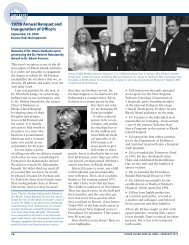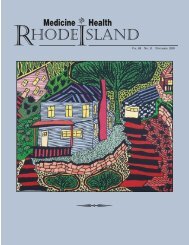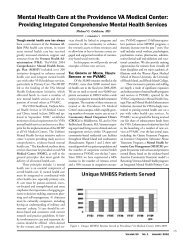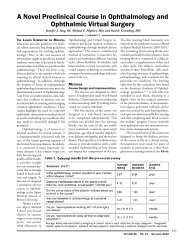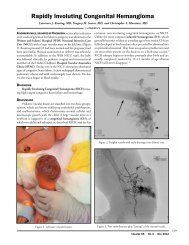Hyperuricemia & Gout - Rhode Island Medical Society
Hyperuricemia & Gout - Rhode Island Medical Society
Hyperuricemia & Gout - Rhode Island Medical Society
Create successful ePaper yourself
Turn your PDF publications into a flip-book with our unique Google optimized e-Paper software.
An Ailment For the Royally Nourished<br />
<br />
A 59 yea- old British physician, in 1683, describes an attack of<br />
articular pain in his patient: “The victim goes to bed and<br />
sleeps in good health. About two o’clock in the morning he<br />
is awakened by a severe pain in the great toe, more rarely in<br />
the heel, ankle or instep. The pain is like that of a dislocation<br />
and yet the parts feel as though cold water were poured over<br />
them. Then follows chills and shiver and a little fever. The<br />
pain, at first moderate, becomes more intense. After a time<br />
this comes to full height accommodating itself to the bones<br />
and ligaments of the tarsus and metatarsus. Now it is a violent<br />
stretching and tearing of the ligaments – now it is a gnawing<br />
pain and now a pressure and tightening. So exquisite and<br />
lively meanwhile is the feeling of the part affected, that it<br />
cannot bear the weight of the bedclothes nor the jar of a<br />
person walking in the room.”<br />
Truly an authentic description of an age-old disorder called<br />
gout. The physician was Thomas Sydenham (1624 – 1689)<br />
and the patient was himself. When physicians describe diseases<br />
in their patients, the descriptions tend to be starkly objective<br />
and coldly impersonal with little of the patient’s inner reactions<br />
to the ailment. But when the physician is both victim and<br />
portrayer of the disease, the narration inevitably takes on dimension,<br />
greater accuracy and more benevolence.<br />
<strong>Gout</strong> was well known to the ancient Egyptians; and despite<br />
the passage of millennia, some of their mummified remains<br />
still contain toes with the characteristic anatomic changes<br />
of gout. The Classical-era Greeks were also familiar with this<br />
unique form of arthritis, calling the disorder podagra.<br />
This much was known about the predilection, pathology<br />
and prognosis of gout by the late 17 th Century, the dawn of<br />
scientific inquiry: It was a disease selectively but not exclusively<br />
of affluent society with a typical onset in late adult life. Men, to<br />
the exclusion of eunuchs, were its prime victims. Women became<br />
vulnerable to gout, but only beyond the menopause. <strong>Gout</strong><br />
seemed to choose its victims from amongst those who ate intemperately,<br />
especially a diet rich in dark meats; those who drank<br />
much, especially red wines such as port; and those who were<br />
obese and exercised little beyond their eccentricities. The British<br />
widely believed that gout was an inevitable retribution for<br />
the excesses of food, wine and debauchery.<br />
There is nothing timid or subtle about gout. It announces<br />
itself stridently; and if the walls are thin enough, even the<br />
neighbors will know when an attack of gout resumes. A powdery<br />
substance infiltrates the tissues near and within the affected<br />
joints. Occasionally this infiltrate accumulates to form a<br />
painful nodule, a calcareous concretion called a tophus. The<br />
Dutch scientist, Anton Leeuwenhoek (1632 - 1723) used his<br />
newly devised microscope to examine the gouty tophi and observed<br />
its white sediment to be composed of microscopic crystals.<br />
About two centuries latter the British physician, Archibald<br />
Garrod (1857 – 1936) demonstrated that gout represented a<br />
disorder of purine metabolism, sometimes hereditary, and was<br />
characterized by an excessive concentration of monosodium<br />
urates in the bloodstream (hyperuricemia) associated with an<br />
increased acidity of the circulating blood. Victims of gout often<br />
developed uric acid kidney stones, yet another source of<br />
exquisite pain.<br />
Many victims of gout in the wine-consuming population<br />
of the 18 th Century concurrently suffered from lead poisoning<br />
(saturnine gout) since many wines, then, were intentionally<br />
adulterated with sweetening agents such as lead acetate. The<br />
incidence of gout, as an inheritable disorder, is quite high in<br />
the indigenous populations of the Pacific region, particularly<br />
the Maori of New Zealand.<br />
<strong>Gout</strong> can be reproduced in experimental animals; but it is<br />
also encountered as a hereditary trait in some species of birds<br />
and reptiles. And paleontologists are quick to point out that<br />
some fossil remains of Tyrannosaurus rex, the great lizard of the<br />
age of dinosaurs, contained the bony changes seen in gout.<br />
<strong>Gout</strong> does not hide. Patients with gout tell the world of<br />
their affliction in their correspondence, diaries, autobiographies<br />
and even complaints to strangers on the streets. Amongst the<br />
founding fathers of this nation, the following had declared<br />
themselves to be the targets of gout: Benjamin Franklin, Thomas<br />
Jefferson, Alexander Hamilton, John Hancock, George<br />
Mason and John Jay. Historians have speculated that it may<br />
have required the anguish of gout to stir their strivings for independence.<br />
But when the biographies of the English leadership,<br />
on the other side of the Atlantic, are then examined, it<br />
appears that gout showed no political favoritism. <strong>Gout</strong> surfaced<br />
in William Pitt, Benjamin Disraeli, King George IV and<br />
Queen Anne. Other historic sufferers included John Calvin,<br />
John Milton, Isaac Newton, Samuel Johnson and even that<br />
champion of the proletariat, Karl Marx.<br />
Sydenham concluded: “<strong>Gout</strong>, unlike any other disease,<br />
kills more rich men than poor, more wise men than simple.<br />
Great kings, emperors, generals, admirals have all died of gout.”<br />
He might have added: “And countless commoners.”<br />
– STANLEY M. ARONSON, MD<br />
Disclosure of Financial Interests<br />
Stanley M. Aronson, MD, has no financial interests to<br />
disclose.<br />
CORRESPONDENCE<br />
e-mail: SMAMD@cox.net<br />
VOLUME 92 NO. 11 NOVEMBER 2009<br />
351




